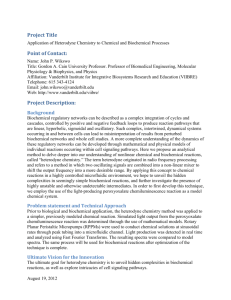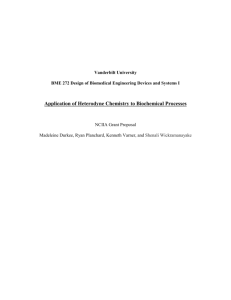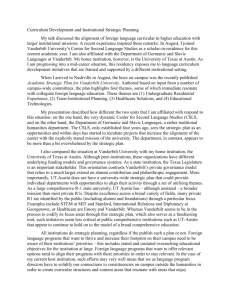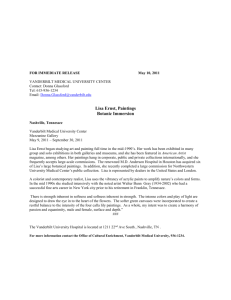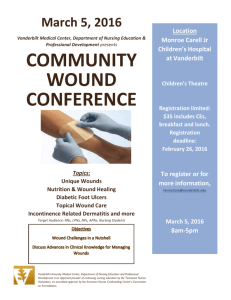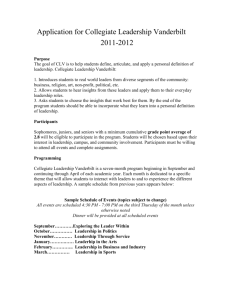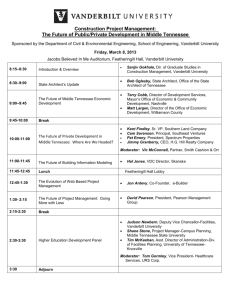Final NCIIA Proposal - Vanderbilt University
advertisement
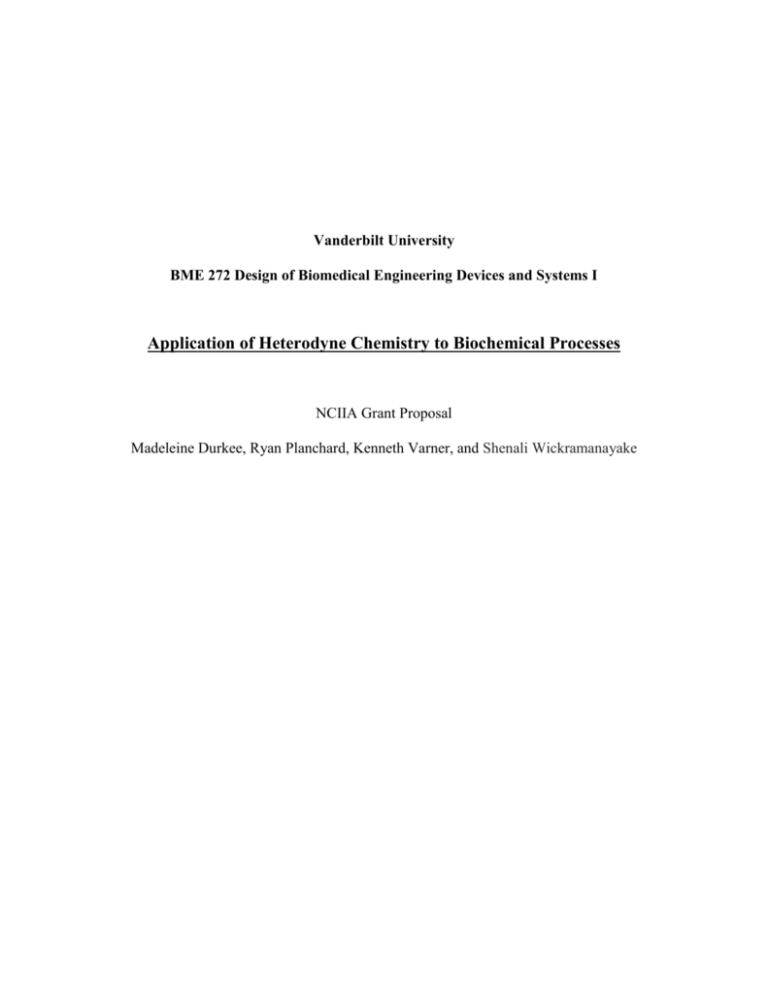
Vanderbilt University BME 272 Design of Biomedical Engineering Devices and Systems I Application of Heterodyne Chemistry to Biochemical Processes NCIIA Grant Proposal Madeleine Durkee, Ryan Planchard, Kenneth Varner, and Shenali Wickramanayake Introduction Biochemical regulatory networks can be described as a complex integration of cycles and cascades, controlled by positive and negative feedback loops to produce reaction pathways that are linear, hyperbolic, sigmoidal and oscillatory. Such complex, intertwined, dynamical systems occurring in and between cells can lead to misinterpretation of results from perturbed biochemical networks and whole cell studies. A more complete understanding of the dynamics of these regulatory networks can be developed through mathematical and physical models of individual reactions occurring within cell signaling pathways. Here we introduce an analytical method to delve deeper into our understanding of nonlinear chemical and biochemical reactions, called “heterodyne chemistry.” The term heterodyne originated in radio frequency processing and refers to a method in which two oscillating signals are combined into a non-linear mixer to shift the output frequency into a more desirable range. By applying this concept to chemical reactions in a highly controlled microfluidic environment, we hope to unveil the hidden complexities in seemingly simple biochemical reactions, and further investigate the presence of highly unstable and otherwise undetectable intermediates. In order to first develop this technique, we employ the use of the light-producing peroxyoxalate chemiluminescence reaction as a model chemical system. Biological processes, such as metabolic reactions, often involve complex steps including reversible reactions that work towards maintaining homeostasis. Current models of biochemical processes, like models of many chemical reactions, oversimplify the process by which this occurs, making identification of the mechanism of action impossible through the use of these models. Pharmaceutical companies need a process to discover the intricate kinetics of the biological systems on the molecular level in order to develop drugs that not only identify therapeutic target and treat the dysfunction occurring in the body, but also avoid contraindications and dangerous side effects. History and Context Prior to biological and biochemical application, the heterodyne chemistry method was applied to simpler, previously modeled chemical reactions. Simulated light output from the fluorescein quenching reaction and the peroxyoxalate chemiluminescence reaction was determined through the use of mathematical models. Rotary Planar Peristaltic Micropumps (RPPMs) were used to conduct chemical solutions at sinusoidal rates through peak tubing into a microfluidic channel. Light production was detected in real time and analyzed using Fast Fourier Transforms (FFTs). The resulting spectra were compared to model FFT spectra. Discrepancies between the model FFT spectrum and the experimental FFT spectrum indicate a flaw in the pre-determined model of the reaction, meaning that there are intermediates that exist that had not previously been accounted for. Given the experimental FFT spectra, actual reaction kinetics can hypothetically be back-calculated, but the process for doing so has yet to be defined. Work Plan/Outcomes The future clinical application of this design will result as an outgrowth of the use of this technique in discovery and translational laboratories. With the ability to gain a thorough understanding of biochemical pathways, investigators will be able to identify the crucial reactants and intermediary products. This will further enhance knowledge of metabolic pathways, and potential offer a more accurate identification process of potential therapeutic targets. The current round of funding will be verifying the efficacy of this methodology against standardized non-linear reactions from scientific literature. Through the comparison of heterodyne experimental data with modeling consistent with previously defined reaction kinetics, we hope to replicate the intricacies of several chemical reactions (fluoroscein quenching, peroxyoxalate, and a fluorescent ATPase reaction). The application of heterodyne chemistry to various biochemical pathways is a natural outgrowth of this proposal. Currently photon emission is our only indicator of product formation, but this phenomena is not consistent with the majority of chemical processes. Other applications of this technique would require real-time tracking of a single/multiple reaction product(s). The development of a microfluidic pH sensor “addon” to the current heterodyne chemistry set up offers a corollary to further verify the efficacy of heterodyne chemistry. The compilation of these data sets will provide the necessary evidence to test on a much larger scale. Future work will entail the tracking of multiple products through the use of mass spectrometry. The development of this system will have the widest applications, but will prove the outgrowth of the foundational research. Our final design product will include a sinusoidal concentration generator (RPPM peristaltic pumps) in concert with a detection system (Either pH or photon detection). These elements will be used to gather heterodyne data which will be directly processed through MATLAB to derive a frequency spectra from the reaction. Translating this spectra into reaction kinetics presents a unique challenge, but also provides the end goal of using this technique to further understand the intricacies biochemical processes. Evaluation/ Sustainability The ultimate goal for this type of procedure would be to be able to accurately model, predict the behavior of, and identify currently undetectable intermediate products of higher order biochemical reactions. However, at this moment we would like to prove the efficacy of this method for identifying all of the intermediates of a reaction by first testing it on known chemical processes. Therefore it is our main concern to prove that this heterodyne model is an accurate and reliable way to characterize these types of reactions. The project will be considered a success if we are able to identify the products and/or rates of the reactions through the detection of changes in both light intensity and pH, as these are currently the simplest ways to track the reactions. The focus reaction will be a fluorescently tagged ATP enzymatic reaction, but the specific reaction has not yet been determined. This will then ensure that we have correctly identified the system so that we can determine the level of accuracy of the current model. Solving the reverse heterodyne chemistry problem, being able to determine chemical equations from a heterodyne chemistry Fourier Transform spectrum, would be considered the ultimate success, but thoroughly solving this problem may not be in the scope of this project. Team Every member of the team has an understanding of reaction kinetics, microfluidics, how to gather frequency measurements using LabView, and how to calculate FFTs. Each member also brings specific knowledge that will be compiled to result in the completion of this project. Kenneth Varner and Ryan Planchard will use MatLab to produce computer models of the chemical reactions. Kenneth Varner will also be constructing and updating a web-page, which will include updates on the design process and images of the project. Ryan Planchard and Madeleine Durkee have experience with similar experimental setups, experimental protocols and data analyses. Madeleine Durkee will also provide specific knowledge on the heterodyne process and provides experience in fabricating microfluidic device masks and microfluidic devices. Shenali Wickramanayake will construct differential equations from the data gathered and use knowledge of chemical kinetics combined with the ability to solve and interpret differential equations to begin the process of solving the problem of reverse heterodyne chemistry. Gantt Chart Madeleine Durkee 1921 Scarritt Place Nashville, TN, 37203 702-506-6249 Madeleine.s.durkee@vanderbilt.edu Education Vanderbilt University Bachelor of Engineering in Biomedical Engineering; May 2013 Engineering GPA- 3.08 Research Experience Searle Systems Biology and Bioengineering Undergraduate Research Experience (SyBBURE) April 2011-present Undergraduate Researcher Developed a novel technique for determining true biochemical and chemical reaction kinetics Fabricated microfluidic device masks and microfluidic devices Collaborated with Cornell University and Hofstra University on various aspects of project development Analyzed Fast Fourier Transform spectrums for frequency content of chemical signals Professional Membership Biomedical Engineering Society February 2010-present President of Vanderbilt chapter May 2011-present o Organized meetings with potential employers o Hosted student information sessions about research Treasurer of Vanderbilt chapter May 2010-May 2011 o Monitored society budget and spending Society of Women Engineers September 2009-July 2010 Member-Helped organize fund raising events for Vanderbilt University chapter Volunteer work/Community Service Children’s Miracle Network Dance Marathon: Raised $150 and attended events with miracle children Miss America/Miss Las Vegas Organization: Raised $200 and visited children in CMN hospitals Project C.U.R.E. Organized medical supplies to send to hospitals in third world countries Recruited Vanderbilt biomedical engineering students to come to Project C.U.R.E. events Technology Access Center Adapted toys for handicapped children Adjusted circuitry in toys by soldering Work Experience Nashville Predators July 2011-present Public and Fan Relations Nashville Parks & Recreation January 2010-present Figure Skating/ Hockey Instructor Vanderbilt University January 2010-present Aerobics Instructor Relative Coursework Biomaterials/mechanics Organic Chemistry Physiology Instrumentation Neuromuscular mechanics BioTransport Therapeutic Bioengineering Ryan Planchard 2301 Vanderbilt Place PMB 355615, Nashville, TN 37235/ 615-973-9951/ ryan.f.planchard@vanderbilt.edu Education Vanderbilt University Aug. 2009 - Present Nashville, TN Major(s): Biomedical Engineering & Economics Minor(s): Chemistry Completed Coursework: Organic Chemistry, Statistics, Multivariable Calculus, Differential Equation, Linear Algebra, Systems Physiology, Bioorganic Chemistry, Medicinal Chemistry, Biomaterials, Biomechanics, Physiological Transport Phenomena, Biomedical Instrumentation Current Cumulative GPA: 3.854 Biomedical Engineering GPA: 3.930 Work Experiences Vanderbilt University – Ingram Cancer Center Aug. 2010 - Present Nashville, TN Lab Technician / Undergraduate Researcher Lab technician in the Oncology Department through the Vanderbilt University work-study program. Participates in research projects under Dr. Utpal Davé, in addition to cleaning and maintaining lab equipment. Vanderbilt University School of Medicine Summer 2012 Nashville, TN Clinical Intern / Undergraduate Researcher Students are provided the opportunity to pursue a research project in an area of interest, allowing for my continued participation in the Davé Lab. Students round with hospital based general medicine residents, and attend weekly seminars to discuss patients seen on rounds, learn about the process of medical education, and discuss issues in health care. Undergraduate Clinical Research Internship Program Vanderbilt University School of Engineering Summer 2011 Nashville, TN Undergraduate Researcher Participated in research projects under Dr. John Wikswo, which required the fabrication and use of microfluidic devices. Project included intensive computer modeling utilizing both MATLAB and COMSOL. Students attended weekly seminars to develop critical research skills including topics such as AutoCAD, Photolithography, Journal Databases, etc. Summer Undergraduate Research Program Honors and Awards Fred J. Lewis Scholarship - Vanderbilt Awarded: 2011-2012/2012-2013 Awarded to students in the School of Engineering with outstanding academic credentials and offering a positive impact within the Vanderbilt community. Tau Beta Pi Initiated: Fall 2011 Engineering Honors Fraternity recognizing Junior undergraduates ranking in the top eighth of their class. Invitation is contingent on both academic achievement and a record of outstanding character. The organization is active within the School of Engineering, and helps coordinate activities and events for undergraduate engineering students. Dean’s List - Vanderbilt Awarded: Fall: ’09 -‘11 Spring: ’10 - 12 Awarded to students achieving a 3.5 GPA or better over the course of a semester. Kenneth Varner Home Address 3025 Trellis Ln Monroe, NC 28110 kenneth.a.varner@vanderbilt.edu Home 704-282-4888 Cell 704-254-6451 Campus Address Vanderbilt University, PMB Nashville, TN 37235 Education Vanderbilt University, Nashville, TN Bachelor of Engineering, Biomedical Engineering, May 2013 Minor: Engineering Management GPA: 3.276/4.0 University of New South Wales, Sydney, Australia Study Abroad Program, July-November 2011 Charlotte Catholic High School, Charlotte, NC High School Diploma, May 2009 Graduated First Honors GPA: 4.32/5.0 Work Experience Bank of America Stadium Concessions Charlotte, NC 2005-2008 Volunteer • Sold concessions in the upper bowl during football games • Met all sales goals Harris Teeter Indian Trail, NC 2007-2011 Customer Service Clerk • Supervised up to ten cashiers and baggers • Dealt with customer complaints and problems Relevant Coursework Introductory Biomechanics Biomedical Materials Clinical Laboratory Sciences Biomaterial Manipulation with Lab Instrumentation Systems Engineering Program and Project Management Activities Best Buddies 2010-Present College students are paired with those who have intellectual and developmental disabilities. Activities Committee, 2012-2013 Biomedical Engineering Society 2010-Present Vice President of Internal Affairs, 2012-2013 Skills • FEMA Introduction to Emergency Program Management • Proficient with Microsoft Office, MATLAB, and Mathematica • Experience with ArcGIS Strengths • Strong communication and presentation skills • Very methodical, thorough, and organized worker Shenali D. Wickramanayake 6003 Heritage View Ct. • Hilliard, Ohio 43026 • (614) 282-7658 PMB 356189 • 2301 Vanderbilt Place • Nashville, TN 37235 Shenali.d.wickramanayake@vanderbilt.edu EDUCATION Vanderbilt University (May 2013) Major: Biomedical Engineering GPA: 3.165 Honors: Vanderbilt University School of Engineering Dean’s List (Spring 2012) EXPERIENCE Vanderbilt University Summer Undergraduate Research Experience, Optics Lab (2012) Image treated breast cancer cells using two-photon microscopy and fluorescence lifetime imaging Quantify cell death differentiation via flow cytometry and microscopy assays Present research poster at poster session Duke University Medical Center, Thoracic Surgery Department (2011) Analyze clinical esophagogastrectomy data Perform western blot, Q-PCR, ELSIA assay and cell culture Observe clinics and surgeries with Dr. Mark Onaitis University of Ruhuna, Sri Lanka (2010) Sort and analyze data on Dengue fever Observe ward rounds and post-ops with Dr. Bhodinayake Great Lakes Environmental Center, (2009) Perform basic tests on factory effluence samples Assist with the preparation and quantification of acute and chronic toxicity tests Columbus Nationwide Children’s Hospital, Biopathology Center (2009) Prepare blood and tumor samples for testing Prepare microscope slides ACTIVITIES Manna Project (2011-present) Vanderbilt One (2010-2011) Inter-American Health Alliance (2009-2011) VOLUNTEER/COMMUNITY SERVICE OACS Zanzibar Service Project (2012), Teacher Teach Chemistry, Biology, and Math to secondary school students Advise secondary school teachers on improved teaching methods Prepare lesson plans Teach English to preschool students Nashville Mobile Market (2011) Salvation Army Soup Wagon (2010) Tutoring Sudanese Refugees at the Lost Boys Center (2010) COURSEWORK Systems Physiology, Tissue Engineering, Biomaterials, Biomechanics, Neuromuscular Mechanics and Physiology, Analysis of Biomedical Data, Logic
